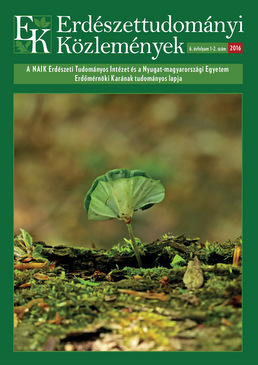| 1. | Andersen, Ch. H. 2015: The effect of human disturbance on nest predation rate of ground-nesting birds. Master thesis. Telemark University College. Faculty of Arts and Science. Telemark. 25. |
| 2. | Báldi A. 1999: A fészekaljpredáció jelentősége, valamint kísérletes vizsgálatának előnyei, hátrányai és módszertana. Ornis Hungarica, 8-9: 39-55. |
| 3. | Báldi, A. and Batáry, P. 2000: Do predation rates of artificial nests differ between edge and interior reedbed habitats? Acta Ornithologica, 35: 53-56. |
| 4. | Báldi, A. and Batáry, P. 2005: Nest predation in European reedbeds: different losses in edges but similar losses in interiors. Folia Zoologica, 54 (3): 285-292. |
| 5. | Batáry P. 2001: Fészekaljpredációs vizsgálatok a Fertő-tó osztrák oldalán. Diplomamunka, Debrecen, KLTE. |
| 6. | Batáry P. 2004: A fészekpredáció szegélyhatásának vizsgálata. Doktori értekezés, Debreceni Egyetem, 91. |
| 7. | Batáry, P. and Báldi, A. 2005: Factors affecting the survival of real and artificial great reed warbler’s nests. Biologia, Bratislava, 60 (2): 215-219. |
| 8. | Carpio, A. J.; Hillström, L. and Tortosa, F. S. 2016: Effects of wild boar predation on nests of wading birds in various Swedis hhabitats. European Journal of Wildlife Research, 62 (4): 423-430. DOI: 10.1007/s10344-016-1016-y |
| 9. | Dawson, S. J.; Adams, P. J.; Huston, R. M. and Fleming, P. A. 2014: Environmental factors influence nest excavation by foxes. Journal of Zoology, 294 (2): 104-113. DOI: 10.1111/jzo.12158 |
| 10. | DeGraaf, R. M. and Angelstam, P. 1993: Effects of timber size-class on predation of artificial nests in extensive forest. Forest Ecology and Management, 61 (1-2): 127-136. DOI: 10.1016/0378-1127(93)90194-r |
| 11. | Faragó S. 2012: Vadászati állattan. Mezőgazda Kiadó, Budapest. |
| 12. | Faragó S. és Náhlik A. 1997: A vadállomány szabályozása. A fenntartható vadgazdálkodás populáció-ökológiai alapjai. Mezőgazda Kiadó, Budapest. |
| 13. | Faragó S.; Csányi S.; Pechtol J.; Szemethy L. és Sztojkov V. 2000: Az apróvad-gazdálkodás stratégiai terve Magyarországon. In: Vadászévkönyv 2000. Dénes Natur Műhely kiadó, Budapest, 112-146. |
| 14. | Fazekas A. és Báldi A. 2000: A szegélyhatás és az énekesmadarak fészekaljpredációjának kísérletes vizsgálata a Tököli Parkerdőben. Ornis Hungarica, 10: 41-48. |
| 15. | Götmark, F. 1992: The effects of investigator disturbance on nesting birds. Current Ornithology, 9: 63-104. DOI: 10.1007/978-1-4757-9921-7_3 |
| 16. | Heim A. és Báldi A. 2009: Különböző élőhelyek szegélyeinek komparatív fészekaljpredációs vizsgálata. Természetvédelmi közlemények, 15: 291-303. |
| 17. | MaCivor, L. H.; Melvin, S. M and Griffin, C. R. 1990: Effects of research avtivity on piping plover nest predation. Journal of Wildlife Management, 54 (3): 443-447. DOI: 10.2307/3809656 |
| 18. | Maier, T. J. and Degraaf, R. M. 2001: Differences in depredation by small predators limit the use of plasticine and zebra finch eggs in artificial-nest studies. The Condor, 103 (1): 180-183. DOI: 10.1650/0010-5422(2001)103[0180:didbsp]2.0.co;2 |
| 19. | Medeiros, R.; Ramos, J. A.; Paiva, V. H.; Almeida, A.; Pedro, P. and Antunes, S. 2007: Signage reduces the impact of human disturbance on little tern nesting success in Portugal. Biological Conservation, 135 (1): 99-106. DOI: 10.1016/j.biocon.2006.10.001 |
| 20. | Panek, M. 2002: Space use, nesting sites and breeding success of grey partridge (Perdix perdix) in two agricultural management systems in western Poland. Game and Wildlife Science, 19: 313-326. |
| 21. | Potts, G. R. 1986: The Partridge: Pesticides, Predation and Conservation. Collins, London. |
| 22. | Potts, G. R. 2012: Partridges. Countryside Barometer. Collins, London. |
| 23. | Purger, J. J.; Csuka, Sz. and Kurucz, K. 2008: Predation survival of ground nesting birds in grass and wheat fields: Experiment with plasticine eggs and atrificial nests. Polish Journal of Ecology, 56 (3): 481-486. |
| 24. | Purger J.J.; Muzinic, J. and Purger D. 2012a: Survival chances of ground nest sin a meadow habitat: A case study in Vrana Lake Nature Park (Mediterranean region, Croatia). Polish Journal of Ecology, 60 (1): 207-212. |
| 25. | Purger J.J.; Kurucz K.; Tóth Á. and Batáry P. 2012b: Coating plasticine eggs can eliminate the overestimation of predation on artificial ground nests. Bird Study, 59 (3): 350-352. DOI: 10.1080/00063657.2012.684550 |
| 26. | Small, M. F. and Hunter, M. L. 1988: Forest fragmentation and avian nest predation in forested landscapes. Oecologia, 76 (1): 62-64. DOI: 10.1007/bf00379601 |
| 27. | Söderström, B.; Pärt, T. and Rydén, J. 1998: Different nest predator faunas and nest predation risk on ground and shrub nests at forest ecotones: an experiment and a review. Oecologia, 117 (1-2): 108-118. DOI: 10.1007/s004420050638 |
| 28. | Starck, J. M. and Ricklefs, R. E. (Eds.) 1998: Avian Growth and Development. Evolution within the Altricial-Precocial Spectrum. Oxford University Press, New York, Oxford. |
| 29. | Sterbetz I. 1984: Fogoly. In: Haraszthy L. (Szerk.): Magyarország fészkelő madarai. Natura Budapest, 67-68. |
| 30. | Trinka, A.; Prokop, P. and Batáry, P. 2008: Dummy birds in artificial nest studies: An experiment with Red-backed Strike Lanius collurio. Bird Study, 55 (3): 329-331. DOI: 10.1080/00063650809461539 |
| 31. | Weidinger, K. 2008: Nest monitoring does not increase nest predation in open-nesting songbirds: inference from continuous nest-survival data. The Auk, 125 (4): 859-868. DOI: 10.1525/auk.2008.07016 |
